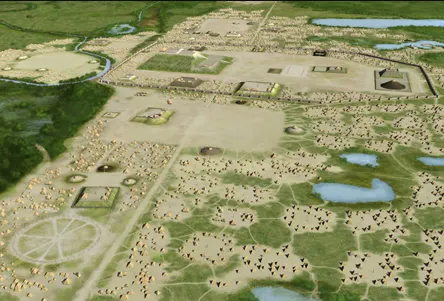
Human fecal remains help shed light on fall of ancient city
The collapse of a sophisticated, ancient society that was located in what is now the United States remains a mystery, but thanks to a recent study that analyzed ancient human fecal remains, more knowledge has been gained about the fall of Cahokia.
Cahokia was a prehistoric Native American civilization with advanced agricultural practices, and then mysteriously vanished about one century before the Europeans reached North America in the late 1400s. Historians cannot confirm what exactly led to Cahokia's collapse, and theories including extreme changes in the environment are most commonly cited.
Located near present-day St. Louis, Missouri, the population of Cahokia grew as high as 20,000 people, and was likely the largest ancient civilization in the United States. It is now a designated historic landmark site, and features iconic manmade earth mounds, which are massive flat-topped pyramids with square bottoms that served as pedastals for civic leaders to live on.

An illustration from 1882 depicting Monks Mound at the Cahokia site, from History of Madison County, Illinois and published by W. R. Brink & Co. Credit: Wikimedia Commons
Most historians theroize that the the inhabitants began abanonding Cahokia around the 1200s, and by 1400 CE it was completely deserted. The recently published study states that climate changes, particularly droughts and flooding, directly correlate with fluctuations in the Cahokia's population size, which was measured using fecal records and environmental data.
The researchers obtained fecal records by collecting fecal stanols, which are molecules that are produced in the human gut during digest and when feces are eliminated. As feces passed from land to waterways, the stanols became trapped in lake sediments, which accumulate in layers over time and were used as an indicator for Cahokia's population size.

Cahokia's east-west baseline transects the Woodhenge, Monk's Mound, and several other large mounds. Credit: Wikimedia Commons
Two of the biggest changes in the environment that were correlated to declines in population include a massive flood of the Mississippi River around 1150 CE and a drought, which were both detrimental to their crops and significantly degraded the environment. These extreme environmental changes created impacts that lasted for decadeds, and ulimately changed the regional climate and challenged the resilience of this ancient society.
The study states that while there were many stressors to the longevity of the Cahokia society, including sociopolitical tensions, the climate changes that occured during this time created significant challenges to society and compromised key resources, such as water and agricultlural resources, which resonates with the current environmental challenges we are facing today.










